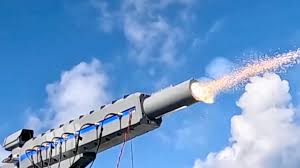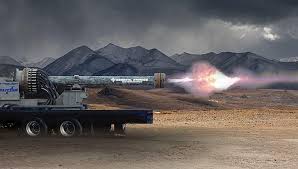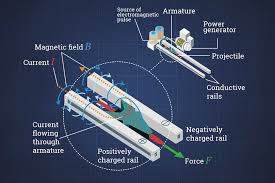
ELECTROMAGNETIC RAILGUNS
INTRODUCTION:

A railgun or rail gun, sometimes referred to as a rail cannon, is a linear motor device, typically designed as a weapon, that uses electromagnetic force to launch high-velocity projectiles. The projectile normally does not contain explosives, instead relying on the projectile’s high kinetic energy to inflict damage.
WORKING PRINCIPLES:
1. Current Flow
- When the railgun is fired, a large electric current is passed from the power supply through one of the rails, through the armature (or projectile), and back along the second rail, completing the circuit.
- The current flowing through the two rails creates a magnetic field around each rail.
2. Magnetic Field Interaction
- According to Ampère’s Law, when a current flows through a conductor, it generates a magnetic field. In the railgun, these magnetic fields around each rail interact.
- The magnetic fields generated by the current flowing through the rails interact with each other, exerting a force on the armature and causing the projectile to accelerate along the rails.
3. Lorentz Force
- The Lorentz force is the key principle behind the railgun’s operation. It describes the force exerted on a charged particle (or conductor) moving through a magnetic field.
- As the current flows through the armature (or projectile), it generates a force perpendicular to both the current and the magnetic field, according to F = I * L * B, where:
- I is the current
- L is the length of the conductor (armature or projectile)
- B is the magnetic field strength
- This force pushes the armature (or projectile) along the rails at high speed.
4. Projectile Acceleration
- The resulting electromagnetic force accelerates the projectile down the rails at extreme speeds. As the projectile moves forward, the current continues to flow through the rails and armature, maintaining the force that pushes the projectile.
- The faster the current and the stronger the magnetic field, the greater the acceleration of the projectile.
5. Exit Velocity
- Once the projectile reaches the end of the rails, it exits the railgun with high velocity, typically at speeds greater than Mach 6 (six times the speed of sound) and sometimes much higher, depending on the power of the system.
- The speed of the projectile is primarily determined by the current, the length of the rails, and the efficiency of the electromagnetic forces applied.

KEY COMPONENTS:
Two Parallel Conducting Rails: These are the main structure of the railgun, through which electric current flows. The rails are typically made of materials like copper, which have high electrical conductivity.
Armature: The armature is a conductor (often a piece of metal) that connects the two rails. The projectile is typically attached to the armature or forms part of it, and as current flows through the armature, it interacts with the magnetic fields generated by the rails.
Power Supply: A powerful electrical power supply is necessary to generate the high current needed to launch the projectile. This supply could be capacitors or large batteries capable of discharging large amounts of energy in short bursts.
Projectile: The projectile is the object being launched. In the case of a railgun, it is usually a conductive material (metallic), as the electromagnetic forces are necessary to accelerate it.
ADVANTAGES:
High Velocity and Range: Railguns can launch projectiles at extremely high velocities, often exceeding Mach 7 (seven times the speed of sound). This allows them to hit targets at long distances with incredible speed, making them highly effective for long-range strikes.
Cost-Effective Ammunition: Unlike traditional projectile systems that require complex, explosive warheads, railguns can fire simple, unpowered projectiles (essentially metal slugs). These projectiles are much cheaper to produce, which reduces the overall cost per shot compared to conventional missile systems.
DISADVANTAGES OF RAILGUN:
Enormous Power Requirements: Railguns require a vast amount of electrical power to accelerate projectiles to high speeds. This power demand can be difficult to supply efficiently, especially in military applications where energy capacity might be limited or costly.
Wear and Tear on Components: The high-speed projectiles and extreme forces exerted within the railgun cause significant wear and tear on its components, particularly the rails and the armature. This results in high maintenance costs and potentially shorter operational lifespans for the system.

